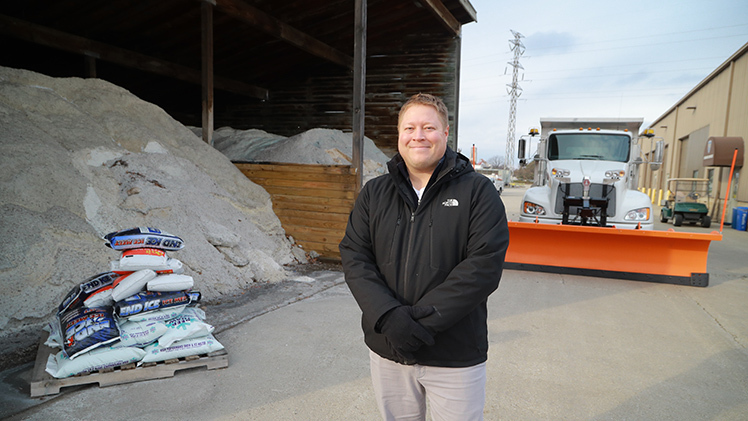Across the U.S., road crews dump around 25 million metric tons of sodium chloride — much like table salt — to unfreeze roads each year and make them safe for travel.
Usage varies by state, but the amount of salt applied to icy roads annually in some regions can vary between approximately 3 and 18 pounds of salt per square meter, which is only about the size of a small kitchen table.

Research by Dr. Bill Hintz, assistant professor of ecology, spotlights how the overuse of road salts to melt snow and ice is threatening our health and the environment.
As the use of deicing salts has tripled over the past 45 years, salt concentrations are increasing dramatically in streams, rivers, lakes and other sources of freshwater.
Overuse of road salts to melt away snow and ice is threatening human health and the environment as they wash into drinking water sources, and new research from The University of Toledo spotlights the urgent need for policymakers and environmental managers to adopt a variety of solutions.
The study titled “Road Salts, Human Safety and the Rising Salinity of Our Fresh Waters” is published in the journal Frontiers in Ecology and the Environment and presents how road salts hurt ecology, contaminate drinking water supplies and mobilize harmful chemicals, such as radon, mercury and lead, and then lays out suggested best management practices.
“The magnitude of the road salt contamination issue is substantial and requires immediate attention,” said Dr. Bill Hintz, assistant professor of ecology at UToledo and lead author of the research based out of the UToledo Lake Erie Center. “Given that road deicers reduce car accidents by more than 78%, we worked to strike a careful balance between human safety and mitigating the negative environmental and health impacts triggered by dumping salt on our streets and highways to keep people safe and traffic moving.”
In one major example, the researchers say overuse of road salts likely contributed to higher levels of corrosive chloride in the water supply in Flint, Mich., in 2014, leading to the release of lead from water distribution pipes.
Another example shows that high concentrations of deicing salt typically occur in private wells located near roads in lower elevations or downhill from highways.
The most common deicers are the inorganic salts sodium chloride, calcium chloride and magnesium chloride, all used both in solid and liquid or brine form.
The study examines how current federal safety limits for salt concentrations established by the U.S. Environmental Protection Agency in 1988 to protect fish, plants and other aquatic life in freshwater ecosystems are commonly surpassed.
Particularly alarming is the number of salinized streams. The research highlights recent studies that show urban streams with salt concentrations that are more than 20 to 30 times higher than the EPA chronic chloride threshold of 230 milligrams per liter.
“Current EPA thresholds are clearly not enough,” Hintz said. “The impacts of deicing salts can be sublethal or lethal at current thresholds and recent research suggests that negative effects can occur at levels far below these thresholds.”
The research suggests several solutions, including:
• Proper storage facilities — covered structures with a concrete base;
• Anti-icing, the application of liquids such as salt brines to road surfaces prior to winter storm events, which prevents ice from bonding to surfaces and aids removal operations;
• Live-edge snowplows composed of multiple smaller plows on springs, which better conform to road surfaces compared to conventional plows with a single fixed edge, to increase the efficiency of snow and ice removal and reduce the need for deicing salt; and
• Post-storm performance assessments to determine whether the treatment used was appropriate for the weather system and if it should be modified in the future.
“Given the lack of ecologically friendly and cost-effective alternatives, broad-scale adoption of best management practices is necessary to curb the increasing salinization of freshwater ecosystems resulting from the use of deicing salts,” Hintz said.
Hintz collaborated with scientists from Montana State University and Rensselaer Polytechnic Institute on the study.